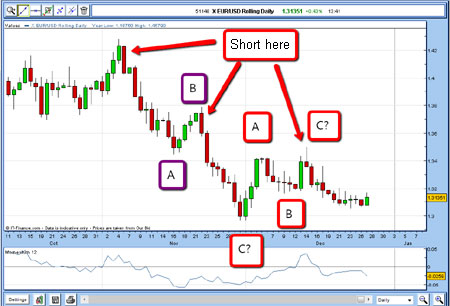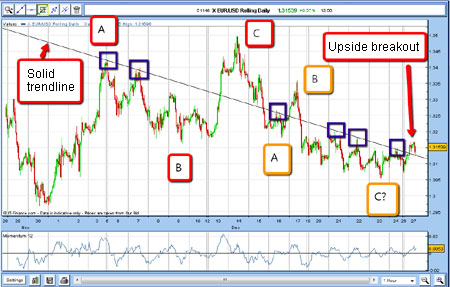What really moves the markets?
When spread betting, the way to win is to master what dictates how the market moves.
Most people who start spread-betting the financial markets are full of hope at the beginning of their trading career.
Sadly, statistics show that the vast majority end up losing money (I should know my very first commodity trade was in corn and I lost on that one). But why?
Having been around the financial markets for some years, I believe the reason most people do not succeed is because they bring the wrong attitude to the markets and to their trading plan (if they have one).
MoneyWeek
Subscribe to MoneyWeek today and get your first six magazine issues absolutely FREE

Sign up to Money Morning
Don't miss the latest investment and personal finances news, market analysis, plus money-saving tips with our free twice-daily newsletter
Don't miss the latest investment and personal finances news, market analysis, plus money-saving tips with our free twice-daily newsletter
In an earlierpost, I described how important it is to develop a methodology for your trading which is consistent with your own personality.
Then you must select the markets in which you wish to operate. I never trade the exotic markets (such as a minor currency cross, or a small cap stock or even a large one, for that matter). Why? Simply because prices can be manipulated very easily whereas it is impossible for any one party to do that in the major markets, such as the FTSE, or the EUR/USD.
To see what I mean, you only have to look at a chart of a small-cap stock, bring up the daily candlestick chart, and see how many 'tails' there are.
The operators have usually opened the day's trading on a low, taking out many stops, and then moved the price back to where it was beforehand.
If you are long and have a close stop, you will suffer.
The other qualities a successful spread-better must have if, like me, you trade market swings (moves of medium duration of a few days to a few weeks), are flexibility and market awareness.
The market is king
It is all very well making a fabulous cast-iron argument based on 'fundamentals' which forecasts that silver will go to the moon, for example but I want to see a chart first and foremost! To show how far wrong you can be trading on a 'story' based on fundamentals, here is a quote from a book on silver:
"The electronics industry has exploded with new technology with the computer and communications industries. It promises to grow even more rapidly in the future. These soaring demands are price insensitive (inelastic).
"This is because the amount of silver used in most industrial applications is so small. Silver is essential to the production of many varied high volume products for which markets are rapidly expanding.
"Market supplies are declining. New mine production is virtually flat. About 75% of new silver production comes as a by-product in the mining of other metals. Silver production has lagged consumption for years.
"The US Treasury (once the largest owner of silver) has been sold out for years."
Care to guess when that was written? If you said 1980 have a cigar! And that came just as silver was topping out at $50/oz (it's now around $30). Of course, the arguments are still valid 30 years later.
Today we have a bonus story of how one very large player (JP Morgan) is cornering the silver futures market (it was the infamous Hunt Brothers back in 1979/80) and threatening to induce a short squeeze.
But there is a huge difference between market analysis and market timing. In short, there are very few good market timers, but plenty of good analysts!
1980 was the all-time silver high after that it entered a bear market for over 13 years, finally bottoming at the $3.50 mark in 1993. Incidentally, that was the time to buy it when it was totally unloved.
So, if trading on the back of a supposedly cast-iron story can seriously damage your wealth, are the markets totally random? Is trading a mug's game, where making money is down to old-fashioned luck?
The answer to that is definitely 'no'. But to understand how markets really work, you must abandon your belief that news and fundamentals move the markets. They do not. The real impulse behind market moves is public sentiment. And since the public are always wrong (or at least, doing the wrong thing), when sentiment gets too one-sided, that is when markets turn.
So the attitude you must develop is to be aware of what the market is thinking and then look to do the opposite (note that there are no readily-available sentiment measures in the minor markets, another good reason not to trade them). The best market swings to trade are mostly the corrections from extreme sentiment readings.
As for profiting from them that's where market timing comes in. Indeed it is the subject of many of my blogs. Here is one recent example.
Trading a swing in EUR/USD market sentiment
In an earlier post, I showed how I have been trading the EUR/USD from the short side since early November, as it made its final thrust to the $1.42 area. These trades were based upon spotting a complete Elliott wave formation and a clear Fibonacci retrace of a previous move.
But one of the most compelling give-away signals for me was the manic level of aversion to the dollar back then (only 3% of investors were bullish on the Daily Sentiment Index).

I shorted the euro again on the wave-C rally (for the same reasons). Things were definitely going my way the EUR/USD was back in its long-term bear market. But one thing was bothering me the market was carving out a series of three-wave Elliott patterns both up and down. This indicates a period of consolidation, not a trending market.
The market should have been trending down in late December the bullish readings had ballooned to the 53% dollar bulls level. But in the space of a few weeks of dollar rally, there was a move from record-low dollar bulls to an equal number of bulls and bears. This was a very rapid turn-around, and had me questioning whether there could be a significant euro rally. After all, most mainstream opinion had become definitely bullish dollar.
In late December, the market was edging down, but not impulsively.
Here is the hourly chart:

I could draw a very solid downtrend line that passed through several significant highs and lows (purple boxes). And then on 27 December, I placed a covering 'buy' order just above the line and was taken out for very significant profits.
Don't be stubborn that's how you lose money
I was very bearish the EUR/USD in November when I began shorting, but then turned more bullish. What made me change my mind? It was the action of the markets (and the background sentiment picture).
If I had stubbornly clung to my belief that the dollar would rally, I would still be in the trade.
The market could possibly have put in a very big rally and I would have lost all my paper profits very disheartening.
This swing trade was successful because I was flexible (prepared to change my stance) and aware of the changes to the technical picture. But it was the market's action (and the lack of an expected trend) that ultimately led me to change tack.
Master the way that sentiment dictates the way the market really moves, and you'll also be one of the winners.
Get the latest financial news, insights and expert analysis from our award-winning MoneyWeek team, to help you understand what really matters when it comes to your finances.
John is is a British-born lapsed PhD physicist, who previously worked for Nasa on the Mars exploration team. He is a former commodity trading advisor with the US Commodities Futures Trading Commission, and worked in a boutique futures house in California in the 1980s.
He was a partner in one of the first futures newsletter advisory services, based in Washington DC, specialising in pork bellies and currencies. John is primarily a chart-reading trader, having cut his trading teeth in the days before PCs.
As well as his work in the financial world, he has launched, run and sold several 'real' businesses producing 'real' products.
-
 Investors will reap long-term rewards from UK equities
Investors will reap long-term rewards from UK equitiesOpinion Nick Train, portfolio manager, Finsbury Growth & Income Trust, highlights three UK equities where he’d put his money
-
 The graphene revolution is progressing slowly but surely
The graphene revolution is progressing slowly but surelyEnthusiasts thought the discovery that graphene, a form of carbon, could be extracted from graphite would change the world. They might've been early, not wrong.